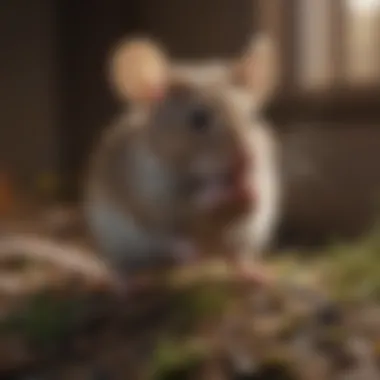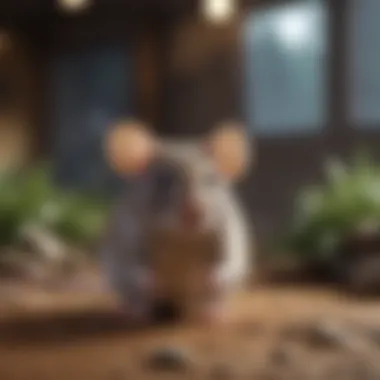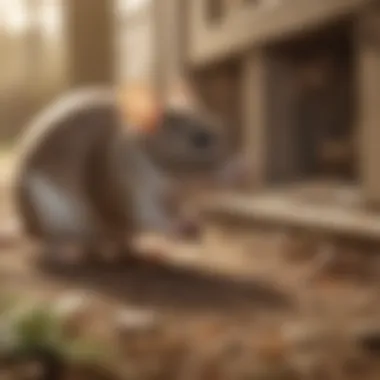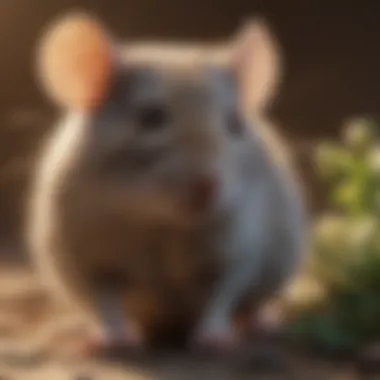House Mouse Removal: Effective Strategies for Management


Intro
The presence of house mice in residential environments poses significant challenges, both in terms of health and property damage. Understanding how to effectively manage these infestations is crucial for homeowners and animal lovers alike. This section provides insight into the house mouse, its behavior, and the necessary strategies to keep them at bay.
Animal Overview
Common Names
House mice are commonly referred to simply as "house mice." Their scientific name is Mus musculus.
Scientific Classification
The classification of house mice is as follows:
- Kingdom: Animalia
- Phylum: Chordata
- Class: Mammalia
- Order: Rodentia
- Family: Muridae
- Genus: Mus
- Species: Mus musculus
Geographic Range
House mice are found worldwide. They thrive in various environments including rural, urban, and suburban settings. Their adaptability allows them to colonize new regions swiftly, often accompanied by human activity.
Behavior and Social Structure
Social Behavior
House mice are known for their social nature. They often live in groups, which can lead to rapid population growth in favorable conditions. Their communal living also enhances their survival, allowing for shared resources and protection against predators.
Communication
Communication among house mice occurs primarily through vocalizations and scent markings. They use high-frequency sounds to convey emotions or alert others to danger. Scent marking plays a crucial role in establishing territory and identifying members within their community.
Mating and Reproduction
House mice have a high reproductive rate. A female can produce several litters each year, with each litter containing up to 12 pups. The gestation period is typically about 19 to 21 days. This rapid reproduction rate contributes significantly to the challenges of managing infestations.
Habitat and Ecosystem
Natural Habitat
House mice are highly adaptable creatures. They can thrive in diverse habitats, such as fields, forests, and human dwellings. Their nesting behaviors lead them to find shelter in warm, undisturbed areas, often within walls or attics.
Food Sources and Diet
As omnivores, house mice have a varied diet. They primarily consume seeds, grains, and fruits, but they will also eat insects and meat when available. Their ability to exploit different food sources aids in their survival in various environments.
Role in Ecosystem
House mice play a dual role in the ecosystem. They serve as prey for various predators, including birds of prey and snakes, thus contributing to the food chain. However, their presence in human habitats can lead to disease transmission and significant damange to structures and food supplies.
House mice are vectors for diseases like hantavirus and salmonella, emphasizing the need for prompt management strategies.
In summary, understanding the house mouse's characteristics and behavior is essential in forming effective pest management strategies. Awareness of their habits and the potential risks they pose to human health can guide actions to minimize infestations.
Foreword to House Mice
Understanding house mice is essential for effective pest management. These small rodents are not just nuisances but can pose various health risks and economic concerns. This section highlights the importance of comprehending the characteristics and behaviors of house mice. By understanding them, one can implement better strategies for removal and prevention.
Overview of House Mice
House mice, scientifically known as Mus musculus, are small mammals commonly found in human habitats. They are typically grey or light brown, with large ears and small eyes. The average size ranges from 2.5 to 4 inches in body length, excluding the tail. House mice are adept at living in close proximity to humans, taking advantage of food sources and shelter that buildings provide. Their swift reproduction rate makes them particularly challenging to control. Understanding their biology is vital for anyone facing a potential infestation.


House mice primarily feed on grains, fruits, and seeds, but their opportunistic eating habits can lead them to consume a wide range of foods. They are nocturnal creatures, often active during the night when they search for food. Due to their small size, house mice can enter through small openings, making prevention more difficult. An infestation can escalate quickly, as a pair of mice can produce up to 30 offspring in a year, causing an overwhelming number of individuals within a short time.
Ecological Role of House Mice
The ecological role of house mice is multifaceted. While often viewed solely as pests, they play important functions in their ecosystems. House mice serve as prey for a variety of predators, including birds of prey and snakes. In this way, they contribute to the food chain, helping to sustain populations of other animals.
Moreover, house mice can influence plant communities by acting as seed dispersers. Their foraging behavior often helps spread the seeds of various plants, which can promote biodiversity. However, their close association with human habitats leads to ecological imbalances, as they thrive in areas altered by human activity.
Overall, recognizing the ecological significance of house mice can inform removal strategies that are more aligned with sustainable practices and wildlife management principles. Striking a balance between pest management and ecological responsibility is crucial in addressing house mouse issues.
Identifying House Mice
Identifying house mice is a crucial step in pest management. Proper identification helps differentiate house mice from other rodents and allows for effective control strategies. The earlier an infestation is recognized, the more manageable it becomes. Understanding the physical characteristics, signs of infestation, and how to distinguish house mice from their counterparts empowers individuals to take action promptly.
Physical Characteristics
House mice exhibit several distinctive physical traits that facilitate their identification. They typically measure about 2.5 to 4 inches in body length, excluding the tail. The tail adds another 3 to 4 inches, making them relatively small rodents. Their fur is fine and can vary in color from light brown to gray, often with a lighter underbelly.
The ears of house mice are large and rounded, providing excellent hearing. Their eyes are small, and their noses are pointed. House mice also have thin, hairless tails, which can serve as a breadcrumb for tracking their movements. These characteristics can be helpful when inspecting for potential infestations.
Signs of Infestation
Identifying signs of house mice infestation is vital for taking action before the problem escalates. Common indicators include:
- Droppings: Small, dark pellets found near nesting areas or food sources.
- Gnaw marks: Evidence of gnawed furniture, wires, or food packaging.
- Tracks: Footprints or trails in dust can indicate recent activity.
- Nests: Shredded paper or fabric located in hidden areas may suggest nesting.
Many of these signs may be found in areas that are hard to reach or observe regularly, such as under sinks, behind appliances, or in attics.
Distinguishing from Other Rodents
It is essential to distinguish house mice from other rodent species to ensure proper pest management. For example, house mice can be easily mistaken for field mice or similar looking rodents. A few key differences include:
- Size: House mice are generally smaller than other rodents like roof rats or Norway rats.
- Tail: The tail of a house mouse is longer in proportion to its body compared to most other rodents.
- Behavior: House mice are more common in urban areas and are typically more social and less wary than their counterparts.
Failing to accurately identify the rodent can result in ineffective treatment strategies, leading to ongoing problems. Thus, proper identification is the foundation of effective removal and management strategies.
“Recognizing the differences between rodents is essential for pinpointing the source of an infestation and ensuring that the correct removal strategy is applied.”
Assessing the Risks of House Mice
Understanding the risks associated with house mice is vital for effective pest management. House mice are not just a nuisance; they can pose serious health and economic risks. Identifying these risks allows individuals and businesses to take informed actions to mitigate potential hazards. This section discusses health hazards and the economic impact of infestations.
Health Hazards
House mice can carry a range of pathogens. They are known to transmit diseases such as hantavirus, salmonella, and lymphocytic choriomeningitis. These illnesses can result from direct contact with mouse droppings or urine, or through bites. Even the simple act of cleaning areas contaminated by mice can pose risks due to infectious particles in the dust.
Here are key health hazards associated with house mice:
- Zoonotic Diseases: Mice can be vectors for diseases that affect humans. As mentioned, hantavirus and salmonella can incubate in human hosts, potentially leading to severe health complications.
- Allergies and Asthma: Proteins found in mouse urine, droppings, and fur can trigger allergies and asthma in sensitive individuals.
- Food Contamination: Mice often scavenge through food supplies. Their droppings and urine can contaminate food and surfaces, introducing harmful bacteria.
Statistics show that homes infested with house mice have higher rates of allergic reactions among family members. Thus, early detection and removal strategies are crucial.
Regular monitoring for droppings or other signs of mouse activity is essential. This practice can be the first line of defense in reducing health risks associated with house mice.
Economic Impact of Infestations
House mouse infestations can lead to significant economic losses for individuals and businesses. The potential fallout includes property damage and costs related to pest control measures. Understanding the economic ramifications is essential in appreciating the urgency of effective house mouse management.
- Property Damage: Mice are known to gnaw on various materials, ranging from wood to electrical wiring. This behavior can compromise the integrity of structures and create fire hazards.
- Lost Revenue: For businesses, a mouse infestation can deter customers, particularly in food service operations. Poor hygiene perceptions can lead to decreased sales and potential closure.
- Pest Control Costs: Employers and homeowners may incur significant expenses for pest control services. While investing in prevention strategies can be more cost-effective in the long run, neglecting an infestation can escalate costs dramatically.


An effective management strategy should not only focus on immediate removal but also on long-term prevention. By understanding the potential health hazards and economic impacts, stakeholders can prioritize their efforts in maintaining a pest-free environment.
Preventive Measures for House Mice
Preventive measures are crucial in managing house mouse populations. Effective prevention not only minimizes the likelihood of an infestation but also addresses the broader implications of having mice in one's dwelling. Preventing house mice requires a multi-faceted approach that emphasizes home maintenance and environmental modifications. These two components work in tandem to create an environment where mice are less likely to thrive.
The importance of preventive actions cannot be overstated. Once house mice establish a presence, they can reproduce rapidly and lead to significant health risks. Infestations can also result in damage to property and economic losses, especially if the situation escalates. By focusing on prevention, homeowners can safeguard their spaces and ensure long-term control over potential infestations.
Home Maintenance Techniques
Home maintenance plays a foundational role in preventing house mouse infestations. Simple upkeep tasks can significantly decrease the chances of mice entering homes. Here are some effective maintenance techniques:
- Sealing Entry Points: Mice can squeeze through very small openings, sometimes as small as a quarter of an inch. Inspect the exterior of your home and seal any cracks or gaps, especially around pipes, windows, doors, and vents.
- Proper Food Storage: Store food in airtight containers to minimize attractants. This applies to pet food as well. Clean up spills and crumbs promptly, as even small food remnants can allure mice.
- Clutter Reduction: Reducing clutter in and around your home can limit hiding spots for mice. Regularly declutter areas such as basements, attics, and garages where mice might seek refuge.
- Regular Inspections: Periodically inspect your property for signs of wear and tear that could provide access to mice. Pay special attention to areas previously known for pest activity.
Implementing these home maintenance techniques creates barriers that deter mice and reduce the likelihood of their presence.
Environmental Modifications
In addition to home maintenance, environmental modifications also play a significant role in deterring house mice. Adapting the environment can make it less inviting for these pests. Consider the following modifications:
- Landscape Management: Keep vegetation trimmed and away from the building. Dense bushes or tall grass near the house may serve as hiding spots for mice and can lead them closer to the home.
- Waste Management: Secure garbage in tightly closed bins. Mice are opportunistic feeders and will be attracted to easily accessible garbage.
- Outdoor Lighting: Installing outdoor lights that illuminate entryways and the perimeter of the house can deter mice from approaching, as they prefer dark and concealed spaces.
- Habitat Modification: If there are areas in the yard where debris accumulates, such as piles of wood or compost, consider relocating these materials. They can attract rodents and provide cover.
These environmental modifications are simple yet effective steps to create a less hospitable atmosphere for house mice and can greatly improve overall pest management.
By proactively addressing home maintenance and modifying environments, homeowners can foster a less appealing setting for house mice, mitigating the risk of future infestations.
Removal Strategies for House Mice
Effective removal strategies are crucial in managing house mouse populations. Given their rapid reproductive rates and adaptability, targeted measures help minimize infestations and restore a healthy environment. Understanding various removal techniques is essential not just for immediate elimination but also for long-term management. Addressing the issue properly can reduce property damage and health risks associated with mice.
Trapping Methods
Trapping is one of the most traditional and widely-used methods for mouse removal. It offers a direct approach to eliminate these pests while allowing for some control over the process. There are several types of traps available:
- Snap Traps: These are simplest. They use a mechanical mechanism to kill mice instantly. Proper placement and bait selection are essential for effectiveness.
- Glue Traps: These traps use an adhesive surface to catch mice. While they can be useful, they are often considered inhumane as they do not provide a quick death.
- Live Traps: Designed to capture mice unharmed, these traps allow for relocation. However, one must ensure that the relocation complies with local wildlife laws.
When setting traps, it is important to position them in areas where mouse activity is evident. Bait can be anything from peanut butter to sunflower seeds, as mice are attracted to strong odors.
Poison Baits
Poison baits are another removal option, but they require careful consideration. These products can be effective in reducing mouse populations. However, one must understand their risks, especially in homes with pets or children. Common types of rodenticides include:
- Anticoagulants: These are the most common. They work by preventing blood from clotting, leading to death over a few days.
- Single-dose baits: Requires less time for a rodent to consume fully. These can be riskier, as they may affect non-target animals if ingested unknowingly.
Precautions are necessary when using poison. Always follow package instructions and place baits in areas inaccessible to pets and children. Regular monitoring of bait stations is also advisable to ensure effectiveness.
Humane Removal Options
For those concerned about animal welfare, humane removal options are available. Various techniques respect the life of the animal while managing infestations. Strategies include:
- Live Trapping: As mentioned, this allows capture without harm. Once trapped, mice can be relocated. Ensure they are taken far from residential areas to prevent return.
- Ultrasonic Repellents: These devices emit sound waves that deter mice. The effectiveness is debated, but some users report success in keeping mice away.
- Natural Predators: Encouraging natural predators, like owls, can help control mouse populations. Installing owl boxes can attract these beneficial birds.
Utilizing humane options requires careful planning and understanding of the mouse's behavior. Ongoing monitoring is essential to prevent re-entry.
Overall, a combined approach that incorporates trapping, poison, and humane options may yield the best results.
In summary, effective removal strategies require forethought and understanding of house mice behavior. Each method has its benefits and considerations, and the choice often depends on the specific circumstances of the infestation.
Professional Pest Control Services


Effective house mouse removal strategies often necessitate professional pest control services. These services are crucial for comprehensive pest management, as they extend beyond mere elimination. Experienced pest control technicians utilize their knowledge, skills, and tools to address infestations at their core. This level of expertise ensures a more thorough approach compared to DIY efforts that may only provide temporary relief.
Hiring a pest control professional is an investment in long-term health and safety in your living environment. The benefits of engaging a professional include not just the eradication of existing mice but also preventive measures tailored specifically to your property's vulnerabilities. Factors such as the structural integrity of your home, potential entry points, and sanitation practices are all evaluated.
Here are some common elements to consider when looking into professional pest control services:
- Expertise and Training: Specialists are well-trained in identifying and dealing with various pest issues, ensuring effective solutions.
- Customized Plans: Services often offer action plans based on your specific situation, which can include targeted treatments and ongoing maintenance.
- Safe Products: Professionals have access to industry-grade pest control products that may not be available to the general public, typically ensuring a safer, more effective application.
Understanding the significance of these services is essential for those dealing with house mice infestations, especially for educators, veterinarians, and animal lovers who prioritize humane treatment and overall environmental health.
Evaluating Service Providers
When evaluating pest control service providers, several insights can lead to better decisions. Key aspects include:
- Reputation: Research the company's history. Look for customer reviews on platforms like Reddit or check their standing on local business listings.
- Qualifications: Confirm that the technicians are licensed and insured. This ensures they are adhering to industry standards.
- Methods Used: Inquire about the techniques and products the company employs. A reputable service will be transparent about their practices.
- Follow-up Services: Effective pest control is not just about the initial treatment. Confirm if they offer follow-up inspections or treatments as needed, ensuring the lasting success of their interventions.
These considerations can greatly influence the outcome of your pest management efforts, guiding you toward a provider that aligns with your specific needs.
Expected Outcomes
The expected outcomes from professional pest control services are multi-faceted. When executed properly, you can anticipate:
- Immediate Reduction of Mice Population: Technicians employ means that are proven effective for swift action against the infestation.
- Long-Term Prevention: The process includes strategies that minimize future risks, such as sealing entry points and improving sanitation practices.
- Health and Safety Assurance: Professionals aim to eliminate safety hazards posed by mice, including disease transmission and property damage.
"Regular monitoring and adjustment of control measures helps ensure the effectiveness of mouse removal strategies in the long term."
Post-Removal Considerations
Post-removal strategies are essential for ensuring long-term success after addressing a house mouse infestation. The approach taken after removal can significantly influence whether mice will return. This stage involves monitoring and prevention techniques that serve to create an environment unfavorable for future incursions. By understanding these aspects, homeowners can maintain control over their living spaces and safeguard against new infestations.
Monitoring for Recurrence
After successfully removing house mice, regular monitoring is crucial. This ensures that any signs of mice returning can be caught early. Keeping an eye out for droppings, gnaw marks, and even nest materials can help identify a potential problem before it escalates.
Here are some effective monitoring tips:
- Inspect regularly in places previously infested.
- Utilize traps set in strategic locations to catch any returning mice.
- Keep a log of any findings to track patterns of activity, should they arise.
Employing these monitoring strategies can prevent future infestations before they become a larger issue.
Ongoing Prevention Techniques
Implementing ongoing prevention techniques is vital for maintaining a mouse-free environment. After the initial removal, focus should shift to proactive measures that deter mice from returning. Below are several techniques:
- Seal any gaps or holes around your home. Mice can squeeze through incredibly small spaces.
- Maintain a clean environment. Regularly cleaning food messes and storing food in airtight containers eliminates potential attractants.
- Trim shrubs and grasses around the home to limit spaces where mice can hide or find shelter.
By integrating these techniques, individuals can create a barrier against future infestations, ultimately contributing to a safer and healthier living space. Staying vigilant and employing these methods ensures the efficacy of mouse management efforts long into the future.
Epilogue
The conclusion of this article synthesizes the insights and strategies discussed throughout the sections. It underscores the significance of effective house mouse management, which is vital not only for protecting the sanctity of one's home but also for ensuring health safety and well-being. House mice can bring various challenges, making it imperative to address them through informed and strategic methods.
Summary of Key Points
- Understanding the identification of house mice is essential for recognizing the signs of an infestation before it escalates into a more severe problem.
- Assessing the health risks associated with house mice highlights the potential hazards they pose to human and pet health, particularly in regard to diseases and allergies.
- Implementing preventive measures can significantly reduce the chances of future infestations, emphasizing the importance of home maintenance and environmental modifications.
- Various removal strategies, including trapping, poison baits, and humane options, can be utilized based on the severity of the infestation.
- The role of professional pest control services can provide additional expertise and a more thorough approach to managing mouse populations effectively.
- Post-removal considerations, such as monitoring for recurrence and ongoing prevention techniques, are essential to maintain a mouse-free environment.
Final Thoughts on Responsible Mouse Management
Responsible mouse management requires a balanced approach. While the desire to eradicate pests quickly is understandable, it is important to consider ethical implications and health aspects. This means opting for humane methods where possible and being mindful of the methods used.
Moreover, developing an understanding of house mice and their ecological roles fosters a more compassionate perspective towards wildlife. As we navigate this complex relationship between humans and rodents, we should aim for solutions that ensure safety for both parties involved.
The objective is not simply removal, but fostering a sustainable coexistence and ensuring our spaces remain healthful and secure.
In summary, the knowledge gained from this article not only aims to equip readers with the tools necessary for effective mouse management but also encourages a thoughtful and responsible approach to the intricate dynamics of human-animal interactions.







